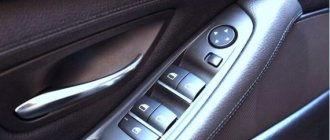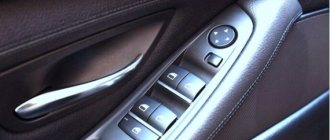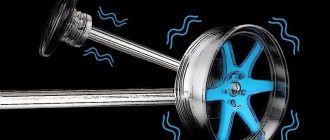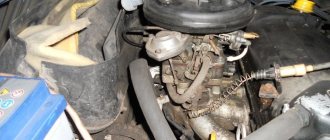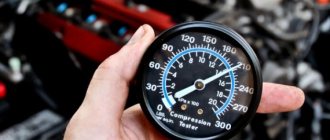02/28/2022 8,024 Heating and air conditioning system
Author: Ivan Baranov
Drivers have long been accustomed to the comfortable conditions in the cabin provided by air conditioning. Therefore, its breakdown significantly affects the well-being of the driver and passengers. Repair and maintenance of car air conditioners is usually carried out by specialists at a service station, but in order to save money, the driver can do this with his own hands, having the necessary tools at hand. The article describes how to detect malfunctions in a car's air conditioner and repair it yourself.
The air conditioner consists of several elements that form a closed system with a front and rear circuit through which freon - coolant - moves. Circulation through the rear and front refrigerant circuits is carried out by a compressor. The compressor compresses the freon, providing pressure in the system. In the compressor, the refrigerant is heated and comes out as a gas. Freon enters the condenser, where the system cools the gas and it turns into condensate.
Then the refrigerant is cleared of impurities in the receiver-dryer and moves to the thermostatic valve (TEV). Next, the liquid refrigerant enters the radiator, where it again turns into a gaseous state. At the same time, it cools the air by absorbing heat from it. The radiator greatly cools the air as it passes through it. Cooled air enters the cabin. Freon returns to the compressor through the rear circuit, and the cycle repeats from the beginning.
Diagram of the car ventilation and air conditioning system
Any element of the air conditioning system may become unusable, which will affect the operation of the entire system. Therefore, you need to figure out what malfunctions may arise, how to diagnose them, why this or that malfunction occurred, and how to fix it.
[Hide]
Condenser is dirty or broken
The condenser is responsible for cooling the liquid, which reduces the temperature of the supply air from the system. In other words, it lowers the temperature of the refrigerant (refrigerant) that takes away heat and releases cooled air. Refrigerants are liquids that change from liquid to gas at temperatures below 0°C.
Condenser contamination leads to poor performance, which is not enough for cooling. That is why the air conditioner automatically turns off.
How it works
A mobile climate control device is not much different from a regular refrigerator in our kitchen. This is a sealed system with a closed circuit through which refrigerant gas circulates.
- When the system starts, the compressor compresses the refrigerant, causing it to become very hot.
- Hot gas under high pressure is driven into a condenser, which is popularly called an “air conditioner radiator,” where it cools and turns into liquid.
- Once in the receiver-dryer, the liquid refrigerant is filtered from dust and other impurities. The freon then enters a thermostatic expansion valve (TEV), which returns it to a gaseous state. The expansion valve is the transition point from high pressure to low pressure in the system.
- The next destination is the evaporator, somewhat similar in structure to a small radiator. The temperature of the gas entering it tends to zero, and interacting with the warm air in the cabin, it begins to boil, cooling the radiator to an icy state.
- The fan “blows the cold away” from the evaporator into the cabin. Completing the cycle, the refrigerant again enters the compressor.
Passing through the evaporator channels, the air leaves moisture on its surface. It falls into the pan and is removed through a special condensate drain.
Car air conditioning compressor malfunction
The main cause of air conditioning failure in a car is due to a broken compressor. This is evidenced by noises and oil leaks from the car's device. Leakage of freon (refrigerant) can cause malfunction. This can happen due to wear of parts of the car air conditioner, electrical circuit malfunction, external damage to parts and, of course, contamination. The main reason remains corrosion. It is because of corrosion that freon leaks, causing the car air conditioner to stop working when faced with a lack of refrigerant.
You can find the location of the leak using car diagnostics at a car service center.
The air conditioner in the car does not work - causes and solutions
A car air conditioner that does not turn on or does turn on but does not cool the interior leads to an equally sad result, although the reasons for this may vary significantly. The most common malfunctions in the car air conditioning system are caused by:
- refrigerant deficiency;
- air conditioner contamination;
- main obstruction;
- problem with the compressor;
- capacitor failure;
- evaporator failure;
- receiver failure;
- failure of the thermostatic valve;
- problems with the fan;
- breakdown of the pressure sensor;
- malfunctions in the functioning of the electrical system.
This is how the air conditioning system in a car works
Not enough refrigerant
If there is a lack of refrigerant in the form of freon in the system, it is automatically blocked. In this case, it is useless to try to turn on the air conditioner using the control unit. No less problematic are attempts to independently compensate for the freon deficiency in the system. Experts say that it is technologically impossible to carry out this operation in a garage. Especially if there is a refrigerant leak in the system, which is impossible to detect on your own. Attempts by some motorists to independently fill the system with R134 freon using a spray can often end with a water hammer that disables the air conditioner. Professionals at service stations fill the air conditioning system with freon using a special installation and charge for the service in the range of 700–1200 rubles.
Experts do not recommend filling the climate control system with freon yourself, although some car enthusiasts do this with varying degrees of success
Air conditioner dirty
This problem is the most common cause of failure of the auto air conditioning system. Accumulating dirt and moisture provoke the formation of corrosion on the main pipes and the condenser, which ultimately leads to depressurization of the cooling circuit. To prevent this phenomenon, you should wash your car more often using a car wash, or when washing your car, do not forget about the engine compartment. Symptoms of excessive contamination of the air conditioner include:
- system failure to turn on;
- spontaneous shutdown while standing idle in a traffic jam;
- switches off when driving at low speed.
This phenomenon is explained by overheating of the device, which leads to an increase in pressure in the circuit and subsequent automatic shutdown of the system. When driving at high speeds, intense air flow onto the components of the air conditioning system allows them to cool down, and the air conditioner turns on again. This situation is a clear signal to thoroughly wash your car.
In this state, the climate control system is unlikely to create comfortable conditions in the cabin.
Circuit obstruction
This circumstance is a continuation of the above and is one of the most common reasons for the failure of the air conditioning system. Dirt that accumulates during the operation of a car in the bends of the line and in areas with low pressure leads to the formation of plugs that prevent the circulation of refrigerant and turn the air conditioner into a useless device. In addition, the performance of the compressor is jeopardized, which begins to experience a lack of lubricant supplied with freon. And from here it’s not far to the compressor jamming - a very expensive breakdown. To eliminate the obstruction of the circuit, you will have to disassemble part of the air conditioner and flush the line under pressure.
Another problem that may occur in the functioning of the circuit is often its depressurization. Most often, it is caused by deformation of oil seals and gaskets under the influence of climatic and external factors. The same thing can happen with main hoses. To eliminate the problem, it is necessary to replace parts of the main circuit that have become unusable, which is advisable to do in a service station. And as a preventive measure, you should turn on the air conditioner at least 2 times a month in winter and let it run for 10 minutes. But it must be remembered that in winter the air conditioning can only be turned on when the interior is warm.
Compressor failure
Fortunately, this problem rarely occurs, since its solution, as already mentioned, is expensive. And it leads to either wear of the unit from long-term use, or a lack of lubrication. The last factor is the main one and is a consequence of the reasons discussed above. In addition, a jammed compressor can cause the air conditioner to sit for an excessively long time without turning it on. In most cases, a jammed compressor requires its replacement, which can only be done with the help of specialists.
It is much easier to solve the problem associated with the failure of the compressor to operate due to the condition of the drive belt. If it is loose or even torn, it must be tightened or replaced with a new one. Both operations are quite feasible for any motorist. As a preventative measure, it is recommended to regularly inspect the drive belt. Even if it is normally tensioned, minor damage to it should already serve as a signal to replace it.
This is what the most important element of the car air conditioning system looks like
Capacitor failure
The condenser of the air conditioning system, located in front of the radiator of the car, is exposed to oncoming air while driving, carrying with it moisture, dirt, dust, debris, and insects. All this clogs the condenser honeycombs and significantly slows down the heat exchange processes, resulting in the device overheating. This immediately affects when the car is in traffic jams or when driving at low speed, as mentioned above.
This element of the car’s climate system stands in front of the radiator and takes on all the debris brought in by oncoming air.
To fix the problem, blow out the condenser with compressed air or rinse it with high pressure water. In this case, it is recommended to remove the radiator grille from the car, unscrew the fastening bolts on the condenser and gain access to its reverse side. An applied insect remover can thoroughly clean the condenser within half an hour, and gasoline can remove oil deposits and other contaminants from it.
If deformed honeycombs are found on the condenser radiator, it is best to straighten them using wooden objects such as a toothpick.
Evaporator failure
Often, turning on the air conditioner is accompanied by the appearance of unpleasant odors in the cabin. Their source is the evaporator, located under the dashboard and representing a radiator. During operation, it can become clogged with dust and accumulate moisture, which creates favorable conditions for the proliferation of microorganisms that emit unpleasant odors.
You can correct the situation yourself by using a special product sprayed using an aerosol can. However, it is more advisable to turn to professionals who have at their disposal equipment for biological and ultrasonic cleaning of not only the evaporator radiator, but also all adjacent air ducts. This is all the more desirable since a clogged evaporator, in addition to causing unwanted odors, can become a source of infectious diseases.
It is from this device that an unpleasant odor can come from inside the car.
Filter drier malfunction
If the car air conditioning system suffers from frequent spontaneous shutdowns, and the system hoses become covered with frost, then this indicates a malfunction of the receiver, also called the filter drier. Its job is to remove liquid from the system and filter the refrigerant. The filter releases freon from waste products that come from the compressor.
Getting to this device is not difficult, which cannot be said about independently detecting a leak.
Frequently, the culprit behind the depressurization of the receiver, due to which it ceases to perform its functions, is the freon itself, for example, grades R12 and 134a. Containing fluorine and chlorine, the refrigerant, when combined with water, forms acids that corrode the elements of the air conditioner. Therefore, air conditioner manufacturers recommend that consumers change the filter drier at least once every 2 years.
Depressurization of the receiver and leakage of freon from it is accompanied by the formation of a white suspension on the surface of the device. Having noticed this, you must immediately contact specialists who will fill the system with gas and dye and, using ultraviolet light, quickly locate the leak. In an amateur garage, doing this on your own is problematic.
Malfunction related to expansion valve
This air conditioner element is designed to optimize the temperature regime and pair it with the pressure in the system, which is necessary for the normal state of the refrigerant. When the thermostatic valve fails, interruptions in the supply of cold air occur. Most often, freezing of the main hoses is observed.
The main reason for failure of this air conditioner part is mechanical damage or incorrect adjustment. In the latter case, the adjustment must be adjusted, and mechanical damage requires replacement of the device. There are also cases when contamination of the system causes the thermostatic valve to jam, which also requires its replacement.
Most often, this faulty device must be replaced
Fan failure
This element of the automobile air conditioning system is not present in all air conditioners, and where it is present, it rarely fails. However, if this happens, it is felt through less efficient cooling of the interior, or even by turning off the device altogether. The functions of the fan are to additionally cool the freon and stimulate the flow of cold air into the cabin. If the fan breaks down, the refrigerant overheats, raising the pressure in the system, which automatically stops its operation. The fan may fail due to:
- break in the power supply circuit;
- electric motor breakdown;
- bearing wear;
- malfunction of pressure sensors;
- mechanical defects in the blades.
Typically, motorists easily detect unreliable contacts in the electrical network and eliminate the fault. As for internal fan defects, most often you have to contact specialists or completely replace the unit.
Its breakdown is immediately noticeable during operation of the air conditioner.
Pressure sensor failure
This element of the car's interior cooling system is designed to turn off the air conditioner when the pressure in the system increases excessively, since pressure higher than normal can lead to physical destruction of the system. The pressure sensor is also responsible for timely turning on or off the fan. Most often, the pressure sensor fails due to excessive contamination, mechanical damage or broken contacts in the connectors. Using computer diagnostics at a service station, a failure in the operation of a given device is detected very quickly. In a garage environment, this is problematic to do, but after making the correct diagnosis, it is not difficult to replace an incorrectly working sensor yourself. To do this, you will need an inspection hole and a “14” open-end wrench. The part replacement process proceeds as follows:
- It is necessary to turn off the engine, since replacement is carried out only with the ignition off.
- Then you need to slightly move the plastic bumper protection and gain access to the pressure sensor located on the right.
- To dismantle it, release the latch on the plug and disconnect the connected wires.
- Now you need to unscrew the sensor with a wrench without fear of freon leakage, since the system has a special safety valve.
- After this, all that remains is to screw the new device into this place and perform the previous steps in reverse order.
This small part is endowed with the ability to automatically turn off the entire climate system
Other possible reasons why the air conditioner does not work
If in most cars, over time, certain problem areas are discovered in the electrical part, then, according to experts, the percentage of poor-quality soldering and weak contacts in connectors in the electrical circuits of air conditioning units is even higher.
Often, the car’s on-board electronics are to blame for the air conditioner’s failure to turn on. For example, when the button to turn on the air conditioning system is pressed, the signal from it is sent to the electronic control unit (ECU) of the car. If there are any problems in the electrical circuit of the system or in the button itself, the ECU may not respond to the signal from the air conditioner button, and the system simply will not work. Therefore, in such a case and as a preventive measure, it is useful to “ring” the electrical circuit of the air conditioning system and the power button itself using a multimeter.
Quite often the compressor's electromagnetic clutch fails. At a service station they usually replace it entirely. This part is expensive, but repairing it piecemeal and independently, as practice shows, is impractical. Firstly, its individual parts in total will cost about the same as a new coupling costs, and, secondly, do-it-yourself repairs are complicated and take a lot of time and nervous energy.
This expensive part most often has to be replaced entirely.
Filter clogging
The air conditioner, having a simple system, has a whole system of filters that provide a flow of cold or warm air. They purify the liquid and remove moisture from the system. It is the clogging of the filters that can lead to a malfunction of the air conditioner in the car. Initially, performance will simply drop, and then complete failure will follow.
Filters require special attention after refilling the air conditioner.
After detecting signs of a malfunction of the air conditioner in your car, it is important to promptly contact a car service for diagnosis, refueling or repair. Timely professional service is the key to success and relative savings. Prices for air conditioner repairs at a car service center depend on the complexity of the work performed.
We repair pipes and hoses
Any air conditioning system on a car includes pipes, rubber gaskets, seals, and line hoses. All of them are connected into a single system, with a front and rear circuit, ensuring its tightness. If one of the elements becomes unusable, then depressurization occurs, water drips and the air conditioner does not work well. After a visual inspection and detection of refrigerant leaks, you need to replace the damaged parts of both the front and rear circuits and top up the system with freon.
Small cracks in aluminum tubes can be repaired with your own hands without tools by treating them with special compounds. They are used to solder cracks in the form of patches. The mixtures are applied to the holes in several layers, the thickness of which is 2-3 mm. If the cracks are large - 2-3 mm wide, then repair of car air conditioners is carried out using argon-arc welding. It is necessary to purchase special tools: a pipe bending machine, a pipe cutter and a welder. Instead of a pipe cutter, you can use a metal file.
In order for the parts of the front and rear circuits to remain elastic, it is necessary for preventive maintenance to constantly use the air conditioner, even in winter, and monitor its cleanliness.
Air conditioning system assembly
A little about oil in refrigerant
Any repair of the compressor is fraught with an imbalance of the oil added to the freon to ensure lubrication of the car air conditioner parts. Since you find yourself forced to restore the compressor’s performance, it would be useful to take into account several recommendations based on experience in repairing climate control systems.
If you are doing work that requires complete dismantling of the compressor, keep in mind that there is still oil in the system, albeit in small quantities - unlike volatile freon, it does not have time to drain either from the lines or from other air conditioner components. To drain these residues, you will have to flush the system. It's expensive, but necessary.
When charging with freon, the required amount of oil has already been added to it, so flushing allows you to achieve the ideal ratio of refrigerant to lubricant. The algorithm for determining the required amount of oil in the system is as follows:
- determine its quantity in the removed compressor;
- Find out from the documentation how much oil there should be;
- subtract the first digit from the last digit and remember the difference;
- When you drain oil from the lines, make sure that its volume is less than or equal to the saved calculated value. If there is excess oil in the system, there is no need to drain it.
Typically, after repairing a compressor, oil needs to be added. How much to add is important, since its excess will cause jamming of the compressor and its complete replacement. If you know how much oil has drained, fill in the same amount plus 40 grams, and it is recommended to use the same type of lubricant. It is also necessary to know that topping up should be carried out exclusively through the high-pressure port - otherwise there is a possibility of creating insufficient vacuum inside the line.
Checking electrical circuits yourself
- You will need a test lamp to check electrical circuits, a simple multimeter with continuity testing and DC current measurement functions. Below is the sequence of checking elements according to the algorithm: from simple to complex.
- Check the integrity of the fuse of the air conditioning control unit, sensors, air conditioning compressor, fans.
- Check the power supply to the relay block (after turning on the ignition, there should be a constant “+” at the power terminal), and the presence of control signals. Using a wire, you can bridge the power contacts instead of a relay. If the chain is working properly, you will hear a click - the clutch has closed with the compressor pulley. If there is no relay as such, power is supplied to the clutch by the control unit. On the compressor itself you will see a connector with one (“+”) or two wires (“-” and “+”). Check if power is supplied to the connector when the engine is running and the air conditioner is on.
- Ring the circuit from the compressor clutch activation relay to the clutch itself. The power terminal of the clutch, to which the relay supplies “+” from the battery when control voltage is applied to the coil, must be connected to ground. To check, connect one terminal to the positive of the battery, the second to the contact in the relay block. If the clutch does not ring, disconnect the connector on the compressor and measure the clutch resistance (should be within 4-6 Ohms). If the winding is fine, the problem is in the wiring. You can verify the break using a multimeter in dial mode.
On constant rotation and combined type compressors, you can additionally check the valve resistance (should be about 8 ohms).
Why is this happening?
If the air conditioner suddenly stops working or turning on, you should not immediately go to the nearest service station and pay for diagnostics and repairs. You can check the unit yourself - many faults can be fixed with your own hands. If the air conditioner does not turn on, experts recommend checking the main units. And to understand what to check first, you need to know some causes and symptoms.
In fact, there are only three reasons why this device may not turn on. This is a non-functional start button, poor or absent contact on the compressor, as well as a low amount of refrigerant. These are all things to check if your air conditioner won't turn on.
Washing methods
Car air conditioning can be cleaned chemically or mechanically. The chemical method involves the use of foam and aerosols. The second method is resorted to if the first one turns out to be useless.
Special cleaning products cost from 150 rubles to 1000 rubles. Cheap cleaners often do not give the desired effect. That is why drivers try to build something from scrap materials. For example, unpleasant odors are removed using chloramine B, lysoformin 3000 and chlorhexidine. The solution is sprayed over contaminated areas. Don't forget to ventilate the salon after treatment.
Replacing the coupling
The clutch is an essential element of a car air conditioner, providing a connection between the compressor shaft and the drive pulley, which rotates constantly, regardless of whether the climate system is on or inactive. Currently, several types of electromagnetic couplings are used, and each type requires the use of its own oil. If this requirement is not met, the coupling is guaranteed to fail much earlier than the mean time between failures. Since the clutch is connected to the pulley, it constantly rotates with it. When you turn on the car air conditioner, you hear a click, which indicates that it has engaged with the compressor shaft, thereby putting it into action.
If a click is not heard, and there is audible noise in the area of the clutch, this is a clear sign that this compressor element is faulty. There are also situations when, according to all external symptoms, the coupling should be working, but the transmission of rotation from the engine to the compressor shaft does not occur. In such cases, diagnostics using special equipment helps to localize the cause of the malfunction. Note that such devices are quite expensive, so they are not found at every service station.
Note that due to the simplicity of the design, the drive coupling is considered a fairly durable unit that breaks relatively rarely. In any case, repairing a car's air conditioning compressor clutch is less profitable than replacing it, since it is inexpensive. And the replacement operation itself is quite simple (especially if you have already dismantled the compressor).
Price list for repair of car air conditioners 2020.
| Replacing the Tebrane O-ring with crimping | 500r |
| Air conditioner line repair (argon/dimet/soldering) | 500r |
| Air conditioner radiator repair | 600rub |
| Air conditioner evaporator repair | 2000rub |
| Air conditioner electrical repair | 550rub |
| Compressor pulley repair (bearing replacement) | 1000r |
| Air conditioner radiator new | 1900rub |
| Air conditioner pipe is new | 2300rub |
| Air conditioner diagnostics | 1200rub |
| Dismantling - installation of the air conditioner radiator with crimping of connections | 1500rub |
| Air conditioner/cooling radiator flushing | 300rub |
| Dismantling - installation of the air conditioner line with pressure testing | 800rub |
Main unit of the climate system
Any air conditioner is essentially a refrigerator. And since both devices can be considered “close relatives,” then their internal structure is relatively the same and assumes that a car air conditioner has a compressor - a heart that accelerates the refrigerant through the system lines. Today, two types of compressors are mainly installed: piston and rotary vane.
Automotive air conditioning compressor
For the piston type, as the name suggests, the main part of the unit will be the piston. Such parts may be present inside the compressor in varying quantities - from one to several. This is where the way the engineering worked plays a role. The location of the pistons can also vary. They can be placed in a V-shape, crosswise and in one plane. The main thing is the ability to compress the coolant element in order to force it to circulate along the car air conditioner line from a high pressure zone (discharge area) to a low pressure zone (suction area).
The design of a rotary vane air conditioning compressor for a car is very similar to an electric pump for an air bed. When the rotor rotates, its blades create cavities that forcefully draw in the refrigerant on one side, and on the other, push it into the main line under pressure, forcing it to circulate through the evaporator pipes.
Design of a rotor-blade unit
The remaining types of automobile compressors number more than 40 modifications, and therefore we will not try to provide information in one article that is unlikely to be useful later. Let us only say that there is a variety of piston-type units with the scientific name “axial-piston superchargers”, which are based on a rotating inclined disk that forcibly pumps a coolant-forming mixture.
Fan failure
If the air conditioner fan does not turn on, this is another reason why the compressor and the air conditioner itself may not start. The function of the fan is to further cool the refrigerant. However, not all air conditioners have this element, and breakdowns are quite rare. Symptoms are noise during operation or a complete absence of any rotation. The temperature inside the car will be slightly higher than necessary.
Causes include worn bearings, electrical problems, mechanical defects and damage.
Repairing the radiator
The air conditioner radiator is located in such a place that it is constantly exposed to various objects: dirt, pebbles, water, salts, etc. Over time, it wears out, corrosion processes occur, and equipment depressurizes. This manifests itself in the fact that the system does not cool the air and water begins to drip.
The best solution in this situation is to buy a new unit, since if you repair the capacitor yourself, there is a high probability that depressurization will occur in another place. Water will drip again and new repairs will be required. In addition, if special equipment, welding and tools are used to troubleshoot problems, the working lines are blocked, which affects the power and productivity of the air conditioner.


